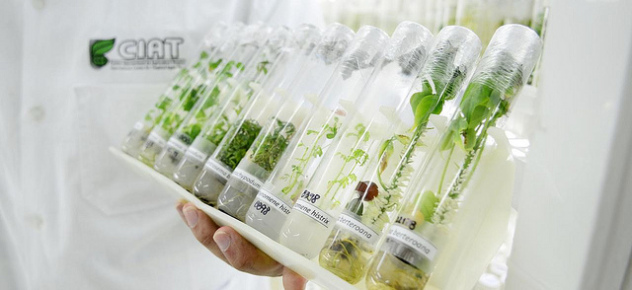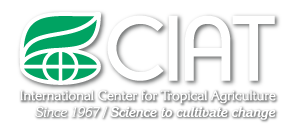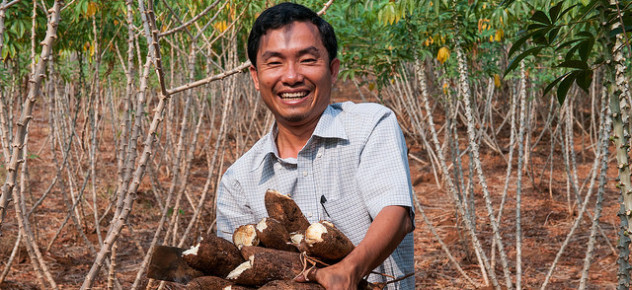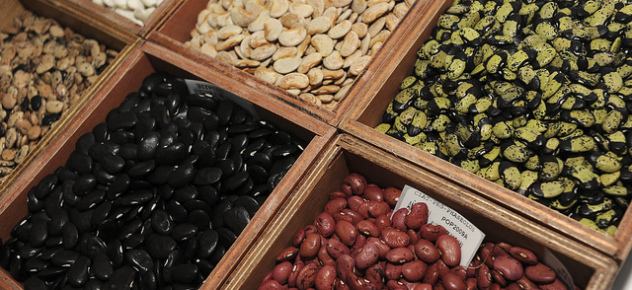Building on biodiversity
 Safeguarding biodiversity is essential for achieving food security. We need crop diversity to be preserved both in farmers’ fields and in modern genebanks. And we need to make it available to all through an efficient global system, now and forever.
Safeguarding biodiversity is essential for achieving food security. We need crop diversity to be preserved both in farmers’ fields and in modern genebanks. And we need to make it available to all through an efficient global system, now and forever.
Crop Wild Relatives are worth 1.9 billion USD a year…Geoff Hawtin discuses PWC audit of CRW #stats #foodsecurity #economics #worthit
— The Crop Trust (@CropTrust) November 10, 2014
Doing its part to ensure long-term conservation and use of crop diversity for food security worldwide, CIAT will construct a new state-of-the-art genebank with LEED (Leadership in Energy and Environmental Design) certification at our headquarters near Cali, Colombia. The new genebank will aim to inspire innovation and international cooperation, not only providing seed and genetic data but also leveraging the power of information to drive transformative agricultural growth. Our goal is to have a new home for CIAT’s bean, cassava, and tropical forages collections ready for inauguration on the occasion of CIAT’s 50th anniversary in 2017.
“Much more than a seed museum, this new genebank will serve as a global knowledge hub for crop diversity, sharing the know-how and genetic resources that developing countries need for responding successfully to pressures like population growth, market shifts, and climate change,” said Cristián Samper, president and CEO of the Wildlife Conservation Society.
A new home for crop diversity
CIAT’s current genebank urgently needs renewal, which can be accomplished with an investment of US$25 million in more effective conservation of more than 67,000 samples of beans, cassava, wild species related to these crops, and tropical forages. The budget includes a $4 million endowment to support genebank operations and efforts to strengthen national scientific capacity.
“Safeguarding biodiversity requires more than just bricks and mortar,” said Joe Tohme, director of CIAT’s Agrobiodiversity Research Area. “This is why CIAT will invest in a world-class training program for the next generation of conservation experts – including the first-ever endowed position in the CGIAR Consortium.”
Alejandro Echeverri + Valencia, an architectural firm based in Medellín, Colombia, impressed the CIAT Board of Trustees with its creative plan for the building, which features a “double skin” or canopy-like structure that will create a cool microclimate, together with modules that allow for economy, flexibility, and expansion in subsequent stages.

The new building will be energy efficient, environmentally friendly, and fully capable of standing the test of time, with offices, tissue culture labs, glasshouses, seed processing areas, and a herbarium – all oriented to:
- Conserving and characterizing crop genetic resources that contribute to sustainable food production and poverty reduction
- Discovering new ways to safeguard and use agrobiodiversity, while also accelerating crop improvement in response to the needs of farmers and consumers
- Educating the next generation of experts in genebank curation and strengthening scientific capacity, while also conveying strong messages to the public about the vital importance of crop diversity
Crop diversity come what may
Crop diversity is rapidly disappearing as a result of urbanization and other pressures, and is also threatened by climate change. Once biodiversity is lost, it’s gone forever. Since 1900, India has lost 90% of its rice varieties, and the USA has lost 90% of its fruit and vegetable varieties. While no one knows the total number of plant varieties that have disappeared, many can be found today only in genebanks like CIAT’s.
Maintaining the greatest possible amount of crop diversity is critical for securing food supplies in the face of unprecedented demand and pressures. We need this diversity to ensure that nutritious food will be available at stable and affordable prices, without expanding agriculture’s environmental footprint. The CIAT genebank is a key resource for meeting these challenges.
Agrobiodiversity impacts
- With traditional fodder sources failing during times of drought, high-quality forage grasses are giving hope to millions of small farmers in Rwanda and other countries of Eastern and Central Africa, where livestock production must be intensified in response to rising demand for milk and meat.
- Using germplasm from CIAT and other CGIAR collections, Brazilian researchers and international partners have developed biofortified varieties of crops that include sweetpotatoes, squash, beans, and cassava, which farmers in Itaguaí are growing to supply nutritionally enriched foods for 13 pre-schools with about 8,000 students.
- Cassava breeders in Asia have developed new varieties that are better adapted to a wide variety of growing conditions, are resistant to pests and diseases, and offer higher starch content, making them more attractive for industrial markets.
With your support
The Building on Biodiversity initiative is well underway but needs support. To this end, CIAT is reaching out to governments, foundations, the private sector, and individuals to establish a global genebank and knowledge hub for agrobiodiversity. We look forward to showing you around the iconic new home for humanity’s crop diversity in 2017.


